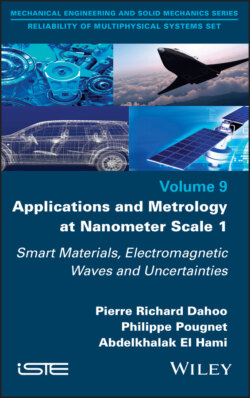Applications and Metrology at Nanometer Scale 1

Реклама. ООО «ЛитРес», ИНН: 7719571260.
Оглавление
Abdelkhalak El Hami. Applications and Metrology at Nanometer Scale 1
Table of Contents
List of Illustrations
List of Tables
Guide
Pages
Applications and Metrology at Nanometer Scale 1
Preface
Introduction
1. Nanometer Scale
1.1. Introduction
1.2. Sample elaboration
1.2.1. Physical and chemical method: spin coating
1.2.2. Physical method: cathode sputtering
1.2.3. Physical method: laser ablation
1.3. Characterization of samples
1.3.1. Scanning electron microscope
1.3.2.Atomic force microscope
1.3.3. Infrared spectroscopy (FTIR/ATR)
1.4. Conclusion
1.5. Appendix: light ray propagation
2. Statistical Tools to Reduce the Effect of Design Uncertainties
2.1. Introduction
2.2. Review of fundamental definitions in probability theory. 2.2.1. Definitions and properties
2.2.2. Random variables
2.2.3. Random vectors
2.2.4. Static moments
2.2.5. Normal probability functions
2.2.6. Uniform probability function
2.3. Random process and random field
2.4. Mathematical formulation of the model
2.5. Reliability-based approach
2.5.1. Monte Carlo method. 2.5.1.1. Origin
2.5.1.2. Principle
2.5.1.3. Advantages and drawbacks
2.5.1.4. Note
2.5.2. Perturbation method. 2.5.2.1. Principle
2.5.2.2. Applications
2.5.2.3. Note
2.5.3. Polynomial chaos method. 2.5.3.1. Origins and principle
2.5.3.2. Note
2.6. Design of experiments method. 2.6.1. Principle
2.6.2. Taguchi method
2.7. Set-based approach
2.7.1. The interval method. 2.7.1.1. Principle
2.7.1.2. Interval arithmetic and stability analysis
2.7.1.3. Conclusion
2.7.2. Fuzzy logic-based method. 2.7.2.1. Principle
2.7.2.2. Conclusion
2.8. Analysis in terms of main components
2.8.1. Description of the approach
2.8.2. Mathematical basis
2.8.3. Interpretation of results
2.8.3.1. Method based on variables
2.8.3.2. Method based on individuals
2.9. Applications. 2.9.1. Rod mesh
2.9.2. Example of a linear oscillator
2.10. Conclusion
3. Electromagnetic Waves and their Applications. 3.1. Introduction
3.2. Characteristics of the energy carried by an electromagnetic wave
3.3. The energy of a plane monochromatic electromagnetic wave
3.3.1. Answer to question 1. 3.3.1.1. First case
3.3.1.2. Second case
3.3.2. Answer to question 2
3.3.3. Answer to question 3
3.3.4. Answer to question 4
3.3.5. Answer to question 5
3.3.6. Answer to question 6
3.4. Rectangular waveguide as a high-pass frequency filter
3.4.1. Answer to question 1
3.4.2. Answer to question 2
3.4.3. Answer to question 3
3.4.4. Answer to question 4
3.4.5. Answer to question 5
3.4.6. Answer to question 6
3.4.7. Answer to question 7
3.4.8. Answer to question 8
3.4.9. Answer to question 9
3.4.10. Answer to question 10
3.4.11. Answer to question 11
3.4.12. Answer to question 12
3.4.13. Answer to question 13
3.4.14. Answer to question 14
3.4.15. Answer to question 15
3.5. Characteristics of microwave antennas
3.5.1. Introduction to antennas
3.5.2. Radiation of a wire antenna
3.5.2.1. Answer to question 1
3.5.2.2. Answer to question 2
3.5.2.3. Answer to question 3
3.5.2.4. Answer to question 4
3.5.2.5. Answer to question 5
3.5.2.6. Answer to question 6
3.5.2.7. Answer to question 7
3.6. Characteristics of networks of microwave antennas
3.6.1. Introduction to networks of microwave antennas
3.6.2. Radiation of antenna networks
3.6.2.1. Answer to question 1
3.6.2.2. Answer to question 2
3.6.2.3. Answer to question 3
4. Smart Materials
4.1. Introduction
4.2. Smart systems and materials
4.3. Thermodynamics of couplings in active materials
4.3.1. Thermo-mechanical and thermoelastic coupling
4.3.2. Multiphysics couplings
4.4. Exercises on the application of active materials. 4.4.1. Strain tensor for 2D thin films
4.4.1.1.Questions
4.4.1.1.Solutions
4.4.2. A piezoelectric accelerometer
4.4.2.1.Questions
4.4.2.2. Solutions
4.4.3. Piezoelectric transducer
4.4.3.1.Questions
4.4.3.2. Solutions
4.4.4. Piezoelectric sensor
4.4.4.1. Questions
4.4.4.2. Solutions
4.5. Appendix: crystal symmetry
Appendix. Propagation of a Light Ray
References
Index. A, C, D
E, G, I
L, M, N
P, R, S
T, U, W
WILEY END USER LICENSE AGREEMENT
Отрывок из книги
Reliability of Multiphysical Systems Set
.....
Chapter 4 deals with functional materials employed in intelligent systems. The main characteristic of these intelligent materials is the coupling of their various physical properties. Thermodynamic coupling and multiphysics coupling are studied for piezoelectric, magnetostrictive and shape memory materials. Application exercises are provided for the deformations of a plate-like thin layer, a piezoelectric accelerometer, a piezoelectric transducer and a piezoelectric sensor.
Pierre Richard DAHOO
.....